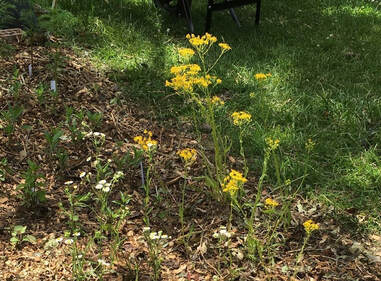
But wait, there’s more.
All the volunteer native flowers I transplanted into my garden survived their traumatic experience too. I’ve read all kinds of gardening advice saying wildflowers will not survive the shock of transplanting and to always wait until they’re dormant. I couldn’t help it. I had to try, and it worked.
I only moved a few Small’s ragwort, daisy fleabane, lance leaf coreopsis, colicroot, and lyreleaf sage from the roadside to my yard. Those species were well represented with lots of cousins peppering the area, so I didn’t feel bad about removing a few of them. I’ll use their seeds next year along with the seeds I collect on my walks. I have my fingers crossed that the bush hog doesn’t chop the rest of the indigenous flora down before they’re ready to harvest.

It’s heart-wrenching to witness the destruction of a habitat that’s been around for eons, untouched, except by the creatures living there. Every year virgin woodlands and meadows are cleared for development. I’ve watched our community expand with new homes, businesses, and farmland. No one seems to realize the hidden price of all this ‘progress.’
It’s not only the flora.
So many insects and other wildlife co-evolved with the vegetation and rely on it for food and shelter. When the trees, shrubs, and bushes disappear, the creatures become homeless and perish.
I spoke with a young man last weekend. His family farms hundreds of acres, and he’s next in line to inherit the business. He was spraying the corn fields with weed killer that day. We spoke of the decline in pollinator populations due to habitat loss, overuse of pesticides, and climate change. He patiently listened as I climbed on my soapbox and ranted against systemic insecticides. Surprisingly, he actually agreed with me.
He cares about how his actions affect the environment and takes great care as he sprays the herbicides. To prevent overspray, he uses the minimum pressure possible, drives slowly, and only sprays when the winds are calm.
That’s a positive start. The problem, though, is his family’s need to make a living as commercial farmers. They want to preserve the native plants, animals, and insects. Yet, they must continue using treated seeds and pesticides to produce the large harvests their livelihood depends on.
It’s a Catch-22.
What do we do? There’s no turning the clock back and returning to the pre-chemicals days when commercial farms were much smaller, and the countryside was more natural.
Is there a compromise?
We need to find a solution to this problem or else…
 RSS Feed
RSS Feed
